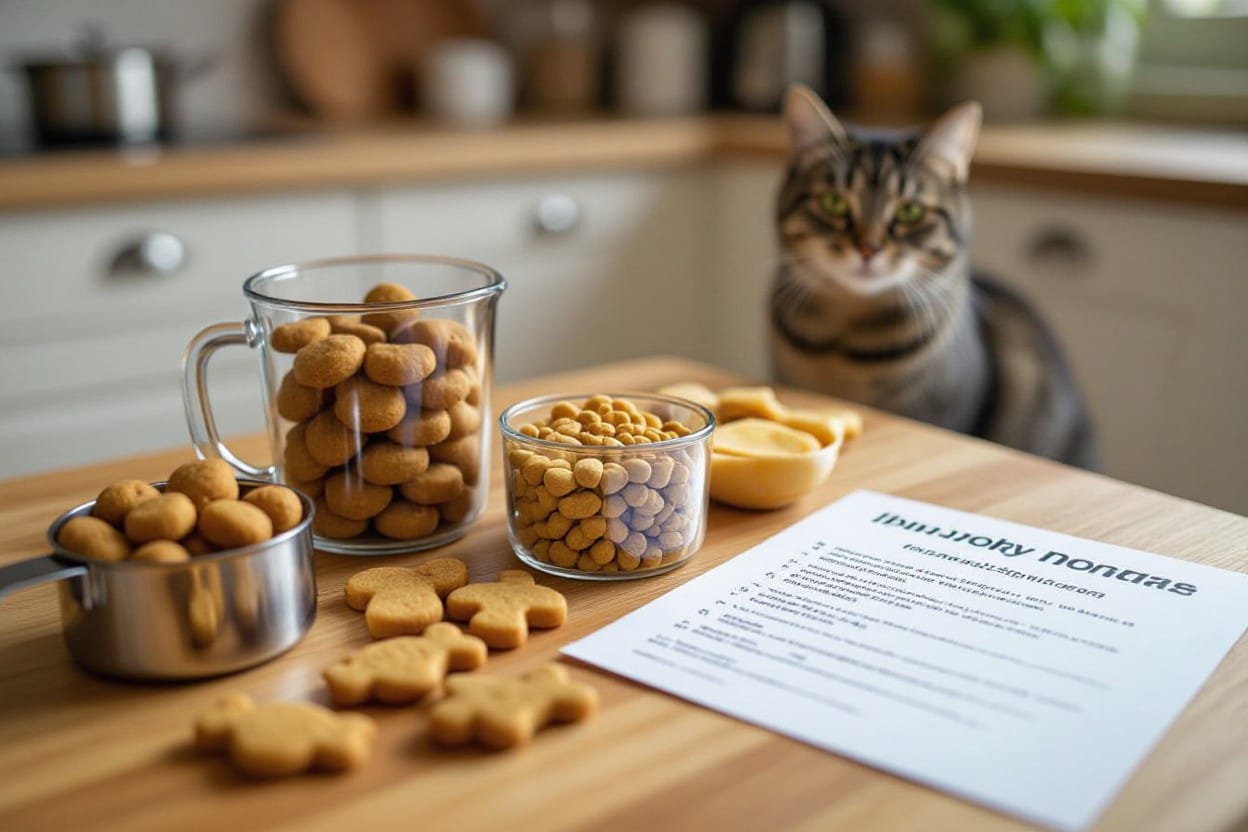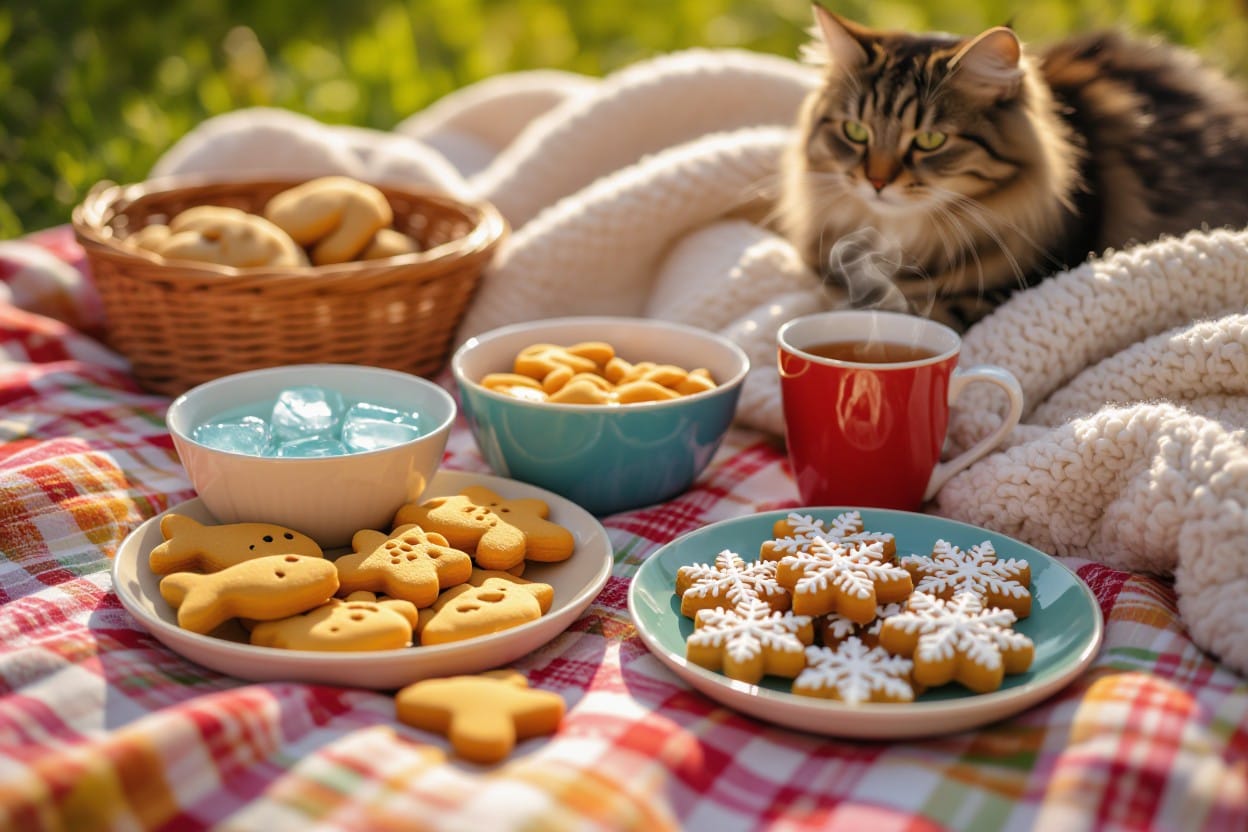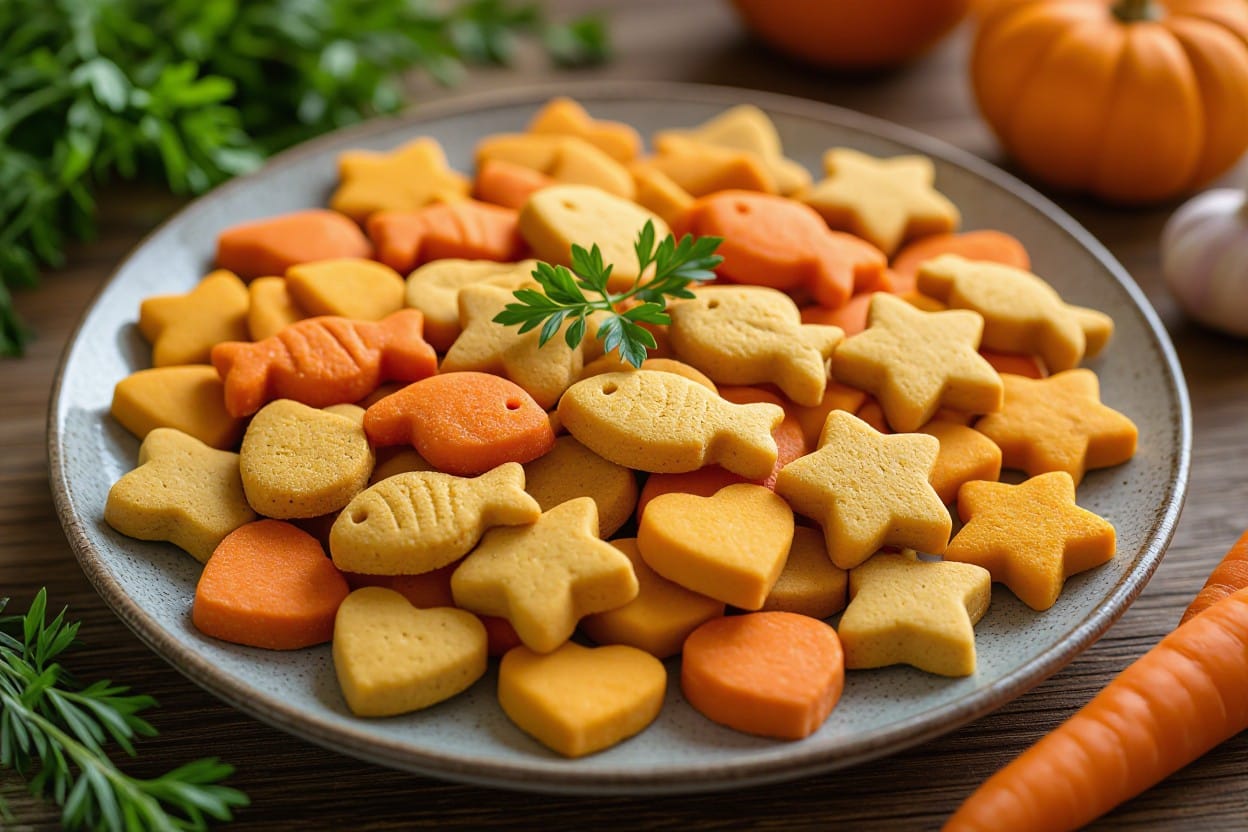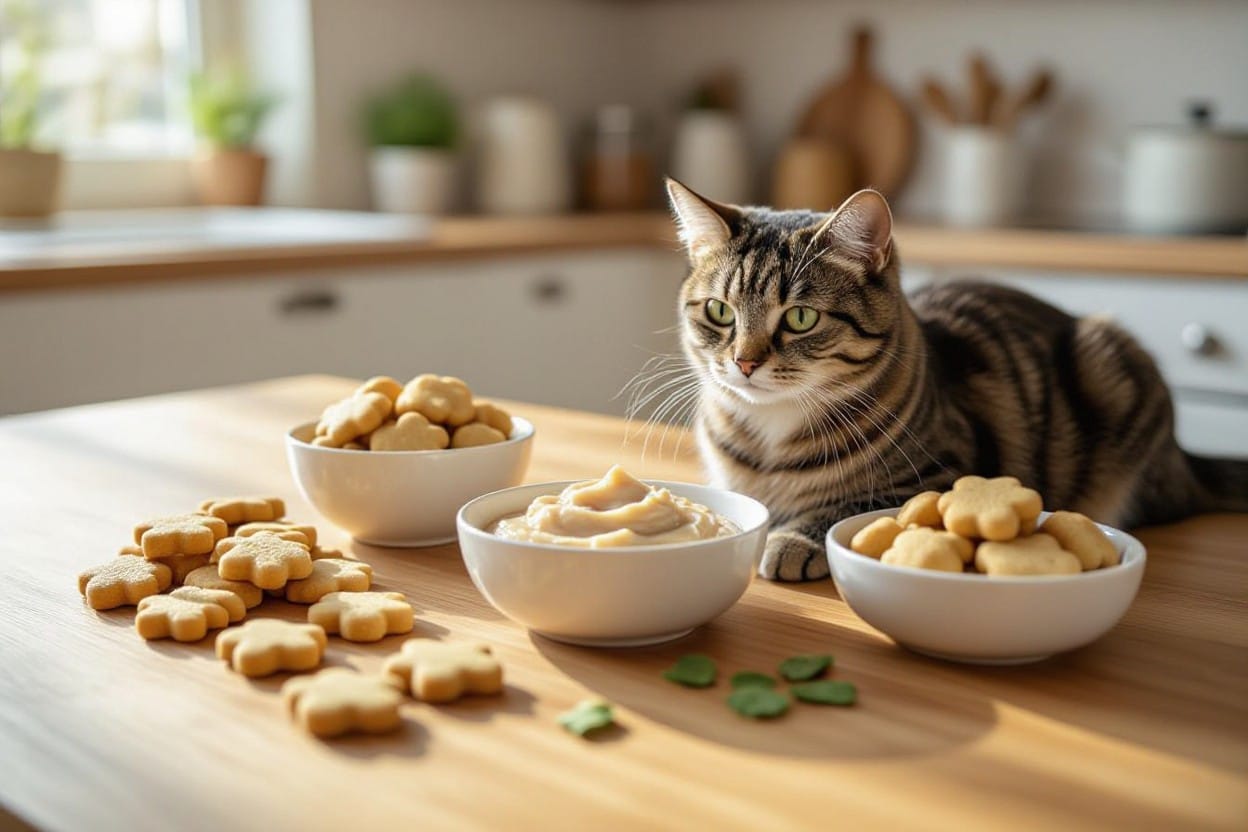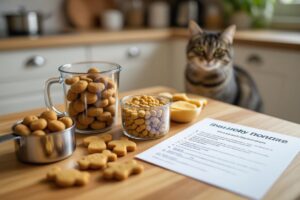Treats you offer should support your cat’s goals: use healthy low calorie cat treats and follow vet-approved recipes so your pet loses weight safely. You can make homemade low calorie cat treats weight loss recipes that serve as effective weight management cat treats and avoid onion, garlic, excess fats; choose lean protein, measured portions, and simple diet cat treats homemade techniques to protect your cat’s health while cutting calories.
Key Takeaways:
- Use vet-approved, high-protein recipes to make healthy low calorie cat treats that support steady weight loss without nutrient gaps.
- Focus on portion control and macro balance when creating weight management cat treats; simple diet cat treats homemade recipes help meet caloric goals while preserving muscle.
- Track treat calories and pet progress—homemade low calorie cat treats weight loss recipes should be tested with vet guidance and adjusted per your cat’s needs.
Understanding Feline Obesity
Prevalence of Cat Obesity
Recent surveys show a significant portion of pet cats carry excess weight: the Association for Pet Obesity Prevention reported approximately 59% of cats were overweight or obese in their national surveys, with other regional studies ranging from about 25% to 60% depending on age, neuter status, and lifestyle. You’ll notice indoor, neutered, and middle‑aged to senior cats consistently appear at higher risk, since lower activity levels and metabolic changes after neutering often push calorie needs down while feeding habits stay the same.
Household feeding patterns matter: free‑feeding dry kibble, frequent snacking, and unmeasured treats all contribute to those prevalence figures. If you track your cat’s body condition score and daily calories, you’ll see how small, repeated overfeeding—like several high‑calorie commercial treats a day—can move a cat from ideal to overweight within months.
Health Risks Associated with Obesity
Obesity raises the risk of metabolic disease: overweight cats are significantly more likely to develop diabetes mellitus, with multiple studies showing roughly a two‑ to three‑fold increase in risk compared with lean cats. Excess fat also predisposes cats to hepatic lipidosis if weight loss occurs too rapidly, because the liver becomes overwhelmed by mobilized fat during starvation or aggressive dieting.
Musculoskeletal and quality‑of‑life consequences are common: obese cats experience increased joint strain and higher rates of osteoarthritis, reduced mobility, grooming difficulties that lead to skin problems, and greater anesthetic and surgical risks. Clinical data link excess weight with measurable declines in activity levels and overall longevity, so managing weight affects both daily comfort and lifespan.
Metabolic and clinical management interact: aggressive calorie restriction without veterinary supervision can precipitate life‑threatening hepatic lipidosis, so you should aim for steady, controlled weight loss (typically around 0.5–2% body weight per week) under a vet’s plan that emphasizes high protein and monitored progress.
The Role of Treats in Weight Management
Treats can be a hidden calorie source: many commercial treats deliver 20–40 kcal each, and a typical indoor neutered adult cat needs roughly 180–250 kcal/day. Allowing multiple treats can push daily intake well above maintenance—ten 25 kcal treats can add 250 kcal, effectively doubling daily calories and driving weight gain. You should treat with a calorie budget in mind, aiming for treats to remain under 10% of daily calories.
Choosing the right treats and delivery methods makes weight control practical: opt for healthy low calorie cat treats or use diet cat treats homemade so you control ingredients and portion size. Low‑calorie options (freeze‑dried chicken pieces, tiny fish flakes, or measured kibble) let you reward behavior without surpassing the daily allowance, and puzzle feeders or short play sessions convert treat time into activity that burns calories.
Practical rules you can apply immediately: set a daily treat calorie limit (for a 200 kcal/day cat, keep treats to about 20 kcal), measure treats with a kitchen scale or calorie chart, and consider homemade low calorie cat treats weight loss recipes that yield 2–5 kcal pieces so you can give several rewards without exceeding the budget. Tracking and consistency will make weight management cat treats an effective part of your cat’s diet plan.
The Importance of Nutritional Balance
Macronutrients: Proteins, Fats, and Carbohydrates
As an obligate carnivore, your cat needs a diet where protein is the primary macronutrient; AAFCO minimums for adult maintenance (about 26% protein on a dry-matter basis) are baseline targets, while many weight-management formulas deliver closer to 30–40% protein to preserve lean mass during calorie restriction. When you make healthy low calorie cat treats, choose lean sources such as cooked chicken breast, canned tuna in water, or egg whites—small pieces of cooked chicken (5–10 g) typically provide only 3–8 kcal per bite, letting you reward behavior without blowing the daily energy budget.
Fat supplies imperative fatty acids and concentrated calories, so keep treat fat low and watch portion size: many commercial treats pack 2–5 kcal each but high-fat add-ins (bacon, oily fish skin) can double that. Carbohydrates have limited metabolic utility for cats and excessive carbs increase glycemic load and weight gain; for weight management cat treats prioritize high-protein, low-fat, and minimal carbohydrate ingredients to help maintain satiety without excess energy.
Micronutrients: Vitamins and Minerals for Health
Small treats rarely provide a meaningful portion of daily vitamins and minerals, yet they can inadvertently unbalance your cat’s intake if you replace complete-meal calories with homemade snacks. Taurine is a non-negotiable example: cats cannot synthesize enough on their own, and long-term deficiency is linked to dilated cardiomyopathy and retinal degeneration, so any diet cat treats homemade recipe that substitutes whole meals should be vetted to ensure adequate taurine and other imperatives.
Liver and organ meats are rich in micronutrients but can be a double-edged sword; frequent feeding of liver causes hypervitaminosis A in cats, while raw fish can introduce thiaminase activity that lowers thiamine. Balance in micronutrient density matters as much as presence—calcium:phosphorus ratios matter especially for growing cats, and unplanned supplementation or high-bone content treats can disrupt that balance and lead to skeletal issues.
When you develop homemade low calorie cat treats weight loss recipes, aim to keep treats small enough that they contribute no more than 10% of daily calories (an average 4–5 kg indoor cat needs roughly 200–250 kcal/day); this helps ensure the bulk of micronutrient needs remain met by a complete, balanced diet or a vet-approved weight-loss prescription. Consult your veterinarian before adding supplements or regular organ-meat treats to avoid unintended deficiencies or toxicities.
The Significance of Fiber in a Cat’s Diet
Fiber types differ in function: soluble, fermentable fibers like beet pulp and psyllium help increase satiety and support beneficial colonic bacteria, while insoluble fibers add bulk and speed transit. For weight management, moderate inclusion—typically in the range of ~3–7% total dietary fiber in formulated diets—can reduce meal-to-meal begging and lower voluntary calorie intake; in practice, adding a small measure of canned pumpkin or a pinch of psyllium to diet cat treats homemade recipes boosts satiety without many calories.
Fiber also stabilizes stool quality and can slow gastric emptying, which reduces post-snack hunger spikes. Studies and clinical experience with obese cats show that increasing fermentable fiber content in the overall diet often improves voluntary food intake regulation, so pairing low-calorie treats with a higher-fiber maintenance diet enhances your chances of sustained weight loss.
Introduce additional fiber slowly to avoid gastrointestinal upset and ensure adequate hydration—excessive insoluble fiber or rapid increases (>10% total fiber) can impair absorption of some nutrients and cause loose stools. For homemade low calorie cat treats, use small, measured amounts of soluble fiber and treat water intake as part of the plan to maintain digestive health and steady weight-loss progress.
Calculating Caloric Needs for Cats
Determining Maintenance Calories
Use the Resting Energy Requirement (RER) formula: RER = 70 × (body weight in kg)^0.75. Multiply RER by an activity factor to get Maintenance Energy Requirement (MER): for typical neutered indoor cats MER ≈ RER × 1.2–1.4, for active outdoor or intact cats MER can reach RER × 1.4–1.6. A 4.0 kg neutered indoor cat has RER ≈ 198 kcal/day and MER at 1.2 ≈ 238 kcal/day, which is the baseline you use to plan meals and treats.
Adjust the MER for age, health status, and body condition score: senior or sedentary cats often sit at the lower end of the MER range, while underweight or highly active cats need the higher end. Log the calculations and your cat’s weekly weight to confirm the MER estimate aligns with stable weight over 2–4 weeks before changing calorie allocations for weight loss or treats.
Establishing Weight Loss Targets
Set a safe weekly goal of about 0.5–2% of body weight loss; faster rates increase the risk of hepatic lipidosis. Start by reducing overall daily intake by roughly 20–25% of MER—for the 4.0 kg example (MER ≈ 238 kcal), a practical weight-loss feeding target is ≈ 190 kcal/day (≈80% of MER). Monitor weight weekly and expect gradual loss; adjust calories if loss is outside the 0.5–2% range.
Avoid feeding below the cat’s RER for prolonged periods; do not drop daily intake below RER = 70 × kg^0.75 without veterinary supervision. Use body condition scoring and regular weigh-ins rather than guessing; if weight stalls for 4–6 weeks, reduce daily calories by a modest 5–10% and reassess.
More detailed monitoring means weekly weigh-ins at the same time and on the same scale, tracking food intake and treat types; if you’re using commercial weight-loss diets, compare package feeding guidelines to your calculated targets and follow your vet’s adjustments to ensure safe progress.
Allocating Daily Treat Calories
Reserve no more than 10% of the weight-loss daily calories for treats to prevent derailing the plan and to make “healthy low calorie cat treats” actually fit into the day. For a 4.0 kg cat on a 190 kcal/day weight-loss target, treats should total about 19 kcal/day—roughly one small freeze-dried chicken bite or a teaspoon of plain canned tuna in water as an example.
Prioritize high-protein, low-fat options and favor “diet cat treats homemade” or single-ingredient freeze-dried proteins labeled with calorie info. Split the treat allowance into multiple tiny rewards for training or enrichment rather than one larger portion; using a measuring spoon or small kitchen scale helps you keep each treat portion consistent.
More info: when you craft “homemade low calorie cat treats weight loss recipes,” aim for portions ≤10–20 kcal each and weigh batches so you know exact calories per piece; substituting treats with interactive feeding or low-calorie enrichment (like food puzzles with the measured daily ration) helps maintain motivation without exceeding your treat calorie cap.
Transitioning to a Low-Calorie Diet
Recognizing Food Sensitivities and Preferences
Watch for gastrointestinal signs such as vomiting, loose stools, or sudden changes in stool frequency within 24–72 hours of introducing a new treat; dermatologic reactions like persistent itching, recurrent ear infections, or patchy fur loss can also indicate a sensitivity. You can run a simple single-ingredient trial by offering only boiled chicken or a plain fish treat for 7–10 days to see if symptoms improve, then reintroduce previous treats to confirm the culprit.
Texture and aroma drive many cats’ choices: some prefer pate-like moist treats while others prefer crunchy bites or freeze-dried meat. Try offering tiny samples—1–2 pieces—of different formats; if your cat consistently ignores fish-based samples but accepts poultry, pivot to healthy low calorie cat treats based on chicken or turkey and avoid ingredients that commonly cause problems such as onions, garlic, xylitol, and high-fat table scraps.
Incorporating Low-Calorie Treats Gradually
Start by replacing no more than 25% of your cat’s treat intake with a lower-calorie option each week so the full swap takes 3–4 weeks; a practical plan is 75% old treats/25% new in week one, 50/50 in week two, and 100% low-calorie by week three. Keep total treat calories to about 10% of daily caloric needs—for an average 4 kg cat that’s roughly 18–25 kcal per day from treats—so if a commercial treat is 5 kcal, limit to 3–4 pieces a day, or cut treats into quarters.
Use micro-rewarding during training: trade one 5-kcal commercial bite for a 1–2 kcal homemade alternative such as a 1 g piece of boiled chicken, small spoonful of canned pumpkin (plain), or a tiny cube of steamed white fish. Implementing diet cat treats homemade like oven-baked 1-cm discs made from pureed chicken and 1 tsp of oat flour can yield treats around 1–2 kcal each and preserve the reward behavior while dropping calories.
For cats that refuse new textures, mix finely crushed low-calorie treats into familiar wet food at a 1:5 ratio for a few days to acclimate smell and taste without causing food aversion.
Monitoring Behavioral Changes
Track appetite, activity, and mood daily; increased begging, pacing at meal times, or sudden lethargy are behavioral signals that the diet or treat timing needs adjustment. Weigh your cat weekly—aim for steady loss of 0.5–2% of body weight per week for safe progress; faster loss raises the risk of hepatic lipidosis and requires immediate veterinary attention.
Create a simple log noting treat type, calories given, and behaviors (e.g., “3/10: ate treats, begged 2x, no GI signs”) and review trends every 2–4 weeks. If weight stalls after 6–8 weeks despite adherence, reassess total caloric intake including food and treats, and consider a veterinary nutrition consult to adjust the plan or rule out medical causes like hypothyroidism or diabetes.
Contact your vet if your cat stops eating for >48 hours, loses >2% body weight per week, shows persistent vomiting/diarrhea, or demonstrates marked behavioral decline—those are signs that the transition may be harming rather than helping your pet.
Low-Calorie Recipe Collection
Ultra-Low Calorie Recipes (Under 3 Calories Each)
You can make healthy low calorie cat treats by turning low-sodium broth and single-ingredient seafood into tiny portions: freeze 1/4 cup low-sodium chicken broth in an ice-cube tray to yield 24 bite-sized cubes at under 3 calories each, or pulse 1 oz (28 g) of whitefish in a blender with a tablespoon of water and portion into 12 micro-dots for similar counts. Freeze-dried single-ingredient flakes (chicken or fish) rehydrated briefly and divided into many micro-servings also keep calories extremely low while preserving aroma that cats love.
You should avoid adding salt, seasoning, bones, or any additives containing onions, garlic, xylitol or other toxic ingredients; those are dangerous even in tiny amounts. Track treat calories against total daily energy needs — most adult indoor cats need about 20 kcal per pound (a 10 lb cat ≈ 200 kcal/day) — and limit ultra-low-calorie bites so treats remain under ~10% of daily intake for effective weight management.
Protein-Rich Low-Calorie Recipes
You’ll boost satiety with high-protein, low-fat bites that still qualify as weight management cat treats. Try an egg-white mini-omelet: whisk one large egg white (~17 kcal), spread thin in a nonstick pan, cool, and cut into 4–5 tiny pieces (~3–4 kcal each). Another option is poached skinless chicken breast: shred 1 oz (28 g) cooked chicken into 6–8 micro-treats to keep portions lean and protein-dense while staying low-calorie.
Dehydrated single-ingredient chicken or fish strips concentrated by a dehydrator produce potent scent and high protein with minimal calories per bite; store in an airtight container and break into small pieces so each treat remains within your daily allowance. Use these approaches for diet cat treats homemade that support muscle maintenance during calorie restriction.
Watch ingredient sourcing: use low- or no-salt canned tuna only occasionally because of mercury and high sodium risks, and always select plain, unsalted protein sources. You should portion protein treats into a dedicated treat log (number and calories) to prevent accidental overfeeding during weight-loss plans like those in many homemade low calorie cat treats weight loss recipes.
Fiber-Enhanced Treat Recipes
You can increase fullness by adding small amounts of soluble fiber to treats: mix 1 tablespoon plain canned pumpkin with 1 tablespoon pureed whitefish, spoon into 12 mini-molds and refrigerate — each bite will be fiber-forward and typically very low in calories. Green bean mash or pureed butternut squash folded with a bit of lean poached chicken makes chewable treats that add volume without fat.
Fiber helps slow gastric emptying and can reduce begging behavior when used as part of a controlled plan; aim for modest fiber additions (a teaspoon to a tablespoon per day divided across treats) and watch stool consistency. Incorporate fiber-based micro-treats among protein and ultra-low-calorie options to keep your cat satisfied without adding excess energy.
Introduce fiber gradually and monitor hydration and stool; excessive fiber can lead to loose stools or reduced nutrient absorption, so you should adjust amounts if you see changes in stool quality or appetite. Highlight positive outcomes like improved satiety and weight-control support, and avoid using high-sugar or seasoned fillers that undermine the goal of healthy low calorie cat treats.
Portion Control Strategies
Effective Measuring and Tracking Techniques
Use a digital kitchen scale to portion treats to the nearest gram rather than guessing by eye; weighing a batch lets you calculate calories per piece. For example, if your homemade batch weighs 500 g and the recipe totals 1,000 kcal, each 5 g treat contains (1,000 / 500) × 5 = 10 kcal per treat. Apply the simple math to any “diet cat treats homemade” recipe so you can keep precise tabs on intake.
Set a daily treat-calorie cap at no more than 10% of your cat’s total daily calories. Use the rule of thumb ~20 kcal per pound of body weight to estimate needs (a 9 lb cat ≈ 180 kcal/day → treat budget ≈ 18 kcal). Track treats in a short log or app, pre-portion into labeled snack bags, and update with any extra samples or training rewards to avoid unintentionally exceeding the limit.
Behavioral Modification for Treat Distribution
Stop free-hand feeding and replace it with structured delivery: timed sessions, food-dispensing toys, or puzzle feeders that require activity to access the treat. Free access to treats leads to overeating; label that behavior as high risk for weight gain and shift to controlled portions. Break commercial treats into quarters so a single “reward” becomes multiple low-calorie responses during training.
Link treats to specific cues and short behaviors rather than casual stroking or begging reinforcement. Use a clicker or verbal marker, deliver one small piece per correct response, and phase in non-food rewards (play, petting, attention) to reduce total treat use while preserving positive reinforcement.
Many owners cut treat calories by switching to single-ingredient dehydrated pieces (chicken, fish) or using tiny kibble bits: if a commercial treat is 8 kcal, cutting it into quarters yields ~2 kcal per reward, letting you perform more repetitions within the same calorie budget without compromising training quality.
Using Treats in Training and Exercise
Favor healthy low calorie cat treats for high-rep training so you can deliver many rewards without blowing the calorie cap. Aim for treats around 1–3 kcal each during active sessions; using regular kibble from your cat’s measured daily ration as rewards is a smart way to keep total calories constant. Examples: target training (touch a post), recall to you, or stationing on a perch—each can use 1–2 kcal pieces and be repeated multiple times.
Incorporate food puzzles and chase-play where treats are earned through movement: hide a few pre-portioned treats in a puzzle feeder or toss tiny pieces into a room to encourage stalking. Short bursts of interactive play (5–10 minutes) paired with treat rewards raise activity levels and make the treat work for calories instead of just adding them.
Plan a session around calorie accounting: for a 9 lb cat with an 18 kcal treat budget, use 2 kcal treats and limit to nine reward events per day; structure those into two 10–15 minute play/training blocks to maximize activity and learning while staying within your “homemade low calorie cat treats weight loss recipes” plan.
Encouraging Active Lifestyles
Incorporating Play into Daily Routines
Schedule short, high-intensity sessions you can stick to: aim for 3 sessions of 10 minutes (morning, mid-day, evening). Use a feather wand or motorized teaser to mimic prey — target 5–8 pounces per session to trigger natural hunting behavior. If your cat weighs about 4 kg, daily maintenance calories are roughly 180–220 kcal; keep treats to no more than 5–10% of that total (about 15–22 kcal/day, or ~5–7 treats at 3 kcal each) when using healthy low calorie cat treats as rewards.
Alternate quick sprint-and-rest intervals with slower stalking games so your cat gets variable-intensity exercise. Use clicker training for tricks (sit, high-five, target touch) to build play into obedience work, and reserve diet cat treats homemade or store-bought low-cal treats for reinforcement. Avoid leaving string-like toys unsupervised and never point a laser directly at the eyes; finish laser play by letting your cat capture a tangible toy or treat to satisfy the hunt.
Creating Engaging Environments for Cats
Provide vertical real estate — window perches, cat trees, shelves 1–2 meters high — and place perches near active views (bird feeders or garden activity) so your cat spends more time moving and observing. Rotate toys every 3–5 days and incorporate food-dispensing puzzles that release single 3 kcal pieces to lengthen engagement; mixing puzzle feeders with homemade low calorie cat treats weight loss recipes can make foraging more rewarding without adding excessive calories.
Scatter 8–12 small treats around different rooms to create a short foraging trail that encourages walking and scent work; replace one meal with a timed food puzzle to increase active feeding time by several minutes per meal. Inspect toys regularly for loose parts and torn seams, and discard anything with small choking hazards or exposed elastic/strings to prevent ingestion or strangulation.
Automated motion toys set to run intermittently when you’re away can prompt activity and reduce boredom; ensure battery compartments are secured and that moving parts are enclosed so your cat can’t get trapped. Use cardboard boxes and paper bags for short, cheap enrichment sessions, swapping them out to maintain novelty.
Understanding the Importance of Exercise
Exercise preserves lean muscle during weight loss, which helps maintain resting metabolic rate so more of the lost weight comes from fat. Combine controlled calorie intake (use healthy low calorie cat treats sparingly) with daily activity: aim for about 30 minutes of active play per day split into short bursts. Set a safe weight-loss target of roughly 0.5–2% of body weight per week; losses greater than 2% per week raise the risk of hepatic lipidosis and require immediate veterinary supervision.
Track progress by weighing your cat weekly and using a 1–9 body condition score; log treat counts and play minutes so you can adjust calories or activity if weight plateaus. Have your veterinarian review any weight-management plan and monitor for signs of rapid weight change or lethargy so you protect muscle mass while moving toward a healthier body composition.
Monitoring Progress and Adjustments
Weekly Weigh-Ins and Trend Analysis
Weigh your cat on the same scale, at the same time of day, after elimination and before feeding; a digital baby or postal scale with 10–20 g precision works best. Track weight in a simple spreadsheet or app and note feeding amounts and treat calories — for a 5 kg cat, a 1% weekly loss equals ~50 g, so a steady decline of 25–100 g over several weeks indicates progress toward a typical safe target of ~0.5–2% body weight per week.
Plot a 4–12 week trend rather than obsessing over single-day fluctuations; short-term variability of ±1–2% is normal. Flag any sharp drops (>2% per week) or prolonged plateaus: rapid weight loss can signal danger (risk of hepatic lipidosis), while a plateau after 6–8 weeks of strict portion control and activity changes suggests you need to recalculate caloric intake or treat load.
Adjusting Caloric Intake Based on Weight Change
Calculate your cat’s resting energy requirement (RER) using RER = 70 × (target weight in kg)^0.75, then aim for a weight-loss feeding amount around 70–80% of that RER under veterinary guidance. Example: for a 4 kg target weight, RER ≈ 70 × 4^0.75 ≈ 198 kcal, so feed roughly 140–160 kcal/day as a starting point while tracking results.
Modify calories in small steps: change total daily intake by about 5–10% every 2–4 weeks based on the trend chart. If weight loss stalls after 3–6 weeks, reduce calories by ~10% or replace higher-calorie snacks with healthy low calorie cat treats and increase interactive play; make each treat count by using diet cat treats homemade options that are 1–5 kcal per piece.
Track treats as part of the daily calorie budget: weigh food portions with a kitchen scale, log calories per treat (commercial labels often state kcal/treat), and prioritize homemade low calorie cat treats weight loss recipes like freeze-dried fish flakes or low-sodium chicken-broth cubes to keep treat calories minimal. Avoid cutting calories drastically—large deficits increase the risk of metabolic problems—so consult your vet before dropping below calculated RER values.
Recognizing When to Consult a Veterinarian
Seek veterinary help if your cat loses >2% of body weight per week, shows anorexia for >48 hours, becomes markedly lethargic, vomits frequently, develops diarrhea, or shows jaundice or behavior changes; these signs can indicate metabolic disease or the onset of life-threatening hepatic lipidosis. Also consult if you observe any lumps, swelling, or sudden changes in drinking or urination patterns.
Contact your veterinarian before implementing aggressive calorie restrictions or if your cat has comorbidities such as diabetes, kidney disease, thyroid disease, a history of hepatic lipidosis, is a kitten, pregnant or nursing, or is geriatric; the clinic can run diagnostics (CBC, biochemical profile, thyroid, urinalysis) to rule out underlying causes and tailor a safe plan.
Veterinary interventions may include precise RER/MER calculations for your cat’s ideal weight, prescription weight-loss diets, supervised refeeding protocols, appetite stimulants if intake is inadequate, and body-condition or composition assessments; many clinics offer weight-management programs with scheduled check-ins to safely guide you and your cat through gradual, monitored progress.
Tools and Resources for Weight Management
Calorie Tracking Systems
Use a digital kitchen scale and a simple tracking sheet or app to convert ingredient weights into calories: a 10 lb (4.5 kg) indoor neutered cat typically needs ~200–250 kcal/day, so keep treats to no more than 10% of daily calories (for a 220 kcal/day target, treats ≤22 kcal). Pull calorie values from product labels or the USDA FoodData Central, then record calories per gram so you can calculate precisely how many calories are in each batch of healthy low calorie cat treats.
Apply a practical workflow: weigh the full batch after baking, divide total calories by the number of pieces, then log calories per treat. Example: if you use 100 g cooked chicken breast (~165 kcal) to make 20 small treats, each treat ≈8 kcal — a manageable value for weight management cat treats used during training or enrichment without blowing the daily budget.
Visual Portion Guides
Develop visual rules of thumb to supplement your scale: one tablespoon of most wet cat foods equals roughly 12–18 kcal, and a thumbnail-sized piece of cooked lean meat usually falls in the single-digit kcal range. Keep a visible cheat sheet (photo or card) showing common portions and their calorie equivalents so you and family members can portion consistently during play, training, or feeding.
For diet cat treats homemade, use measuring spoons or small silicone molds to produce uniform pieces and freeze leftovers in individual portions (ice cube tray or pill organizer). Break larger freeze-dried or dehydrated pieces into pea- or thumbnail-sized bits for training sessions to keep each reward small yet motivating.
Label containers with calories per portion and arrange daily portions into color-coded compartments; this prevents guesswork and helps you stick to planned distributions for homemade low calorie cat treats weight loss recipes, especially during multi-person households where overfeeding is a common problem.
Dietary Supplement Considerations
Evaluate supplements (fiber, L‑carnitine, omega‑3s, probiotics) as adjuncts, not replacements, for calorie control: some studies and clinical reports suggest L‑carnitine can help preserve lean mass during calorie restriction, and soluble fiber can increase satiety. Choose products formulated for cats, check for clear ingredient lists and dosing, and keep expectations realistic — supplements typically provide modest support rather than dramatic weight loss.
Be alert to safety issues: many supplements are not tightly regulated, formulations can vary, and human products sometimes contain ingredients toxic to cats (xylitol, certain vital oils). Look for manufacturers that provide third‑party testing or a NASC membership, bring supplement labels to your vet for review, and stop any product that causes vomiting, diarrhea, or behavioral change.
Track outcomes closely: weigh your cat every 1–2 weeks and aim for safe loss of about 0.5–2% body weight per week; ask your veterinarian to calculate appropriate supplement dosing and to monitor bloodwork if you add metabolic or fat‑mobilizing agents.
The Role of Veterinary Guidance
Importance of Regular Vet Check-Ups
Schedule rechecks every 4–6 weeks during active weight loss so you and your vet can track progress on the 1–9 body condition score (BCS) and actual weight. You should expect taped measurements, a weigh-in on a calibrated scale, and adjustment of the calorie prescription based on measured loss; many programs target roughly 0.5–2% body weight per week to avoid metabolic stress. Monthly reweighs let you compare planned versus actual loss and prevent both stagnation and overly rapid decline.
Baseline diagnostics often accompany the first visit: CBC, chemistry panel, urinalysis, and thyroid testing for older cats. Those tests help rule out conditions that mimic or worsen obesity—diabetes, renal disease, hyperthyroidism, dental pain, or arthritis—so your plan for healthy low calorie cat treats and meal portions is built on an accurate health picture.
Understanding Weight Management Plans
Your vet will calculate a tailored calorie target using your cat’s ideal weight and resting energy requirement (RER), commonly estimated from formulas like 70 × (kg^0.75) or simplified maintenance multipliers. Plans frequently place your cat at about 60–80% of maintenance calories to create a controlled deficit; for some cats that means starting at 150–220 kcal/day depending on size and activity. Prescription weight-loss diets are often used first because they deliver balanced nutrition while you control calories.
Treats must fit inside the calorie budget: keep treats ≤10% of daily calories to preserve progress. If your cat’s daily allowance is 200 kcal, limit treats to roughly 20 kcal — that’s where weight management cat treats or carefully measured diet cat treats homemade recipes become useful. Use small-pulse rewards (single pieces during training) rather than free-access snacking.
Example: a 12-lb (5.4 kg) cat whose ideal weight is 10 lb might start at ~180 kcal/day with a 15–20 kcal treat allowance; you should reweigh after 4 weeks and expect ~0.5–1% weekly loss. If loss stalls, your vet may reduce calories slightly, increase activity recommendations, or switch to a higher-protein, lower-fat prescription diet rather than relying solely on homemade low calorie cat treats weight loss recipes.
Recognizing Signs of Underlying Health Issues
Watch for rapid weight loss, increased drinking, persistent vomiting, or marked appetite changes—these are red flags that warrant immediate evaluation. Other subtle clues include reluctance to jump, altered litter habits, or a sudden drop in grooming; each can indicate pain, endocrine disease, or gastrointestinal problems that sabotage a weight program.
When you observe concerning signs, diagnostics your vet may order include blood glucose (persistent readings >200 mg/dL raise diabetes concern), T4 for hyperthyroidism, CBC/chemistry, urinalysis, and sometimes abdominal imaging. Results guide whether you follow a caloric-restriction path or treat an underlying disease first, because certain conditions change nutritional needs dramatically.
Avoid allowing your cat to stop eating during weight loss—if your cat goes without food for >48 hours contact your vet immediately because of the risk of hepatic lipidosis. Case examples show older indoor cats with osteoarthritis can gain weight from reduced mobility; addressing joint pain alongside a vet-approved diet and measured healthy low calorie cat treats produced steady, safe loss and improved activity within 8–12 weeks.
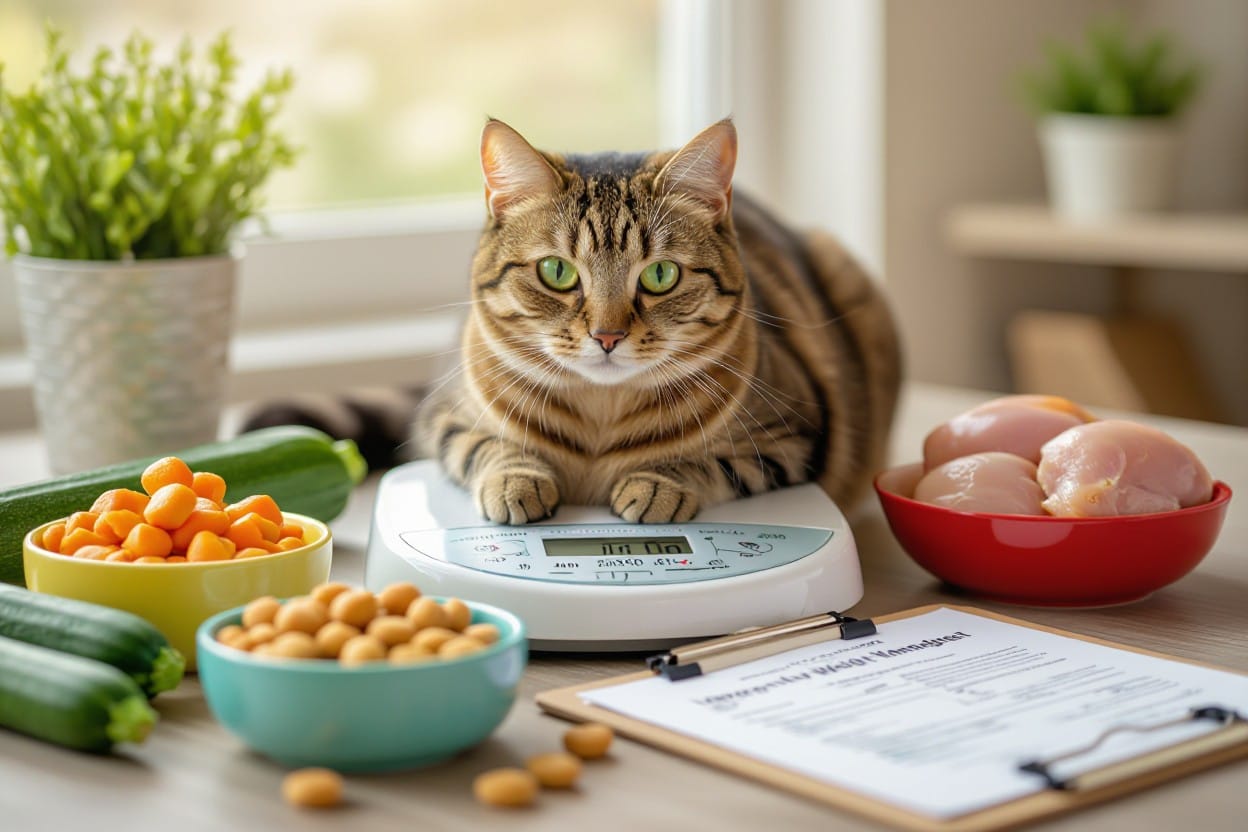
Addressing Common Myths about Cat Weight Management
Myth: All Treats are Bad
Plenty of treats can fit into a weight-management plan when you choose healthy low calorie cat treats and control portions: many commercial bite-sized treats contain only 2–5 kcal each, so a few strategically used pieces can serve as training rewards without blowing daily limits. If your cat requires ~200 kcal/day (typical for an 8–10 lb indoor neutered cat), keep treats to no more than ~10% of daily calories—about 20 kcal—so you preserve room for balanced meals.
Making diet cat treats homemade lets you control ingredients and calories: pureed white fish or cooked chicken, piped into tiny dollops and baked or freeze-dried pieces often come in at 2–8 kcal per bite. You can use homemade low calorie cat treats weight loss recipes such as single-ingredient freeze-dried chicken portions or pumpkin-based chews to add variety without excess energy, and your vet can sign off on specific recipes for medical weight-loss plans.
Myth: Cats Self-Regulate Their Intake
Free-feeding dry kibble assumes cats will stop at the right amount, but many indoor and neutered cats have reduced energy needs and will overconsume when food is always available; studies report up to 60% of domestic cats are overweight or obese, indicating self-regulation often fails. Neutering can lower energy requirements by roughly 20–30%, so an unadjusted portion size that worked before surgery can become excessive.
Free access to kibble is a common driver of weight gain; switching to measured meals, timed feedings, or portion-controlled puzzle feeders forces you to control total daily calories and slows eating, helping you avoid unnoticed extra intake. Use a kitchen scale and calculate calories per gram from the label so every feeding is precise—if a treat contains 3 kcal and your treat budget is 20 kcal/day, you’re limited to six of those treats.
Track weight weekly and aim for steady progress: many vets recommend targeting about 0.5–1% body weight loss per week to lower the risk of hepatic lipidosis, and adjusting portion size, treat allowance, and activity based on that trend offers a defensible, measurable approach.
Myth: Weight Loss is Just About Food
Diet changes matter, but addressing activity, environment, and medical issues is equally important: arthritis, insulin resistance, and hormonal changes can blunt weight-loss efforts even with reduced calories. Adding only 10–20 minutes of structured play twice daily and environmental enrichment like climbing shelves or puzzle feeders often improves fat loss while preserving lean mass, making your calorie reductions more effective.
High-protein, moderate-fat diets that preserve muscle are often recommended during weight loss, and weight management cat treats or diet cat treats homemade options can supply extra protein with low energy cost. Prescription weight-loss formulas plus increased activity typically outperform food-only strategies because they address metabolism, satiety, and behavior together.
Calculate energy needs using RER = 70 × (weight in kg)^0.75 and work with your vet to set a target calorie intake and activity plan; do not rush weight loss, monitor body condition and weekly weights, and combine portion control, enrichment, and medical screening for the safest, most effective outcome.
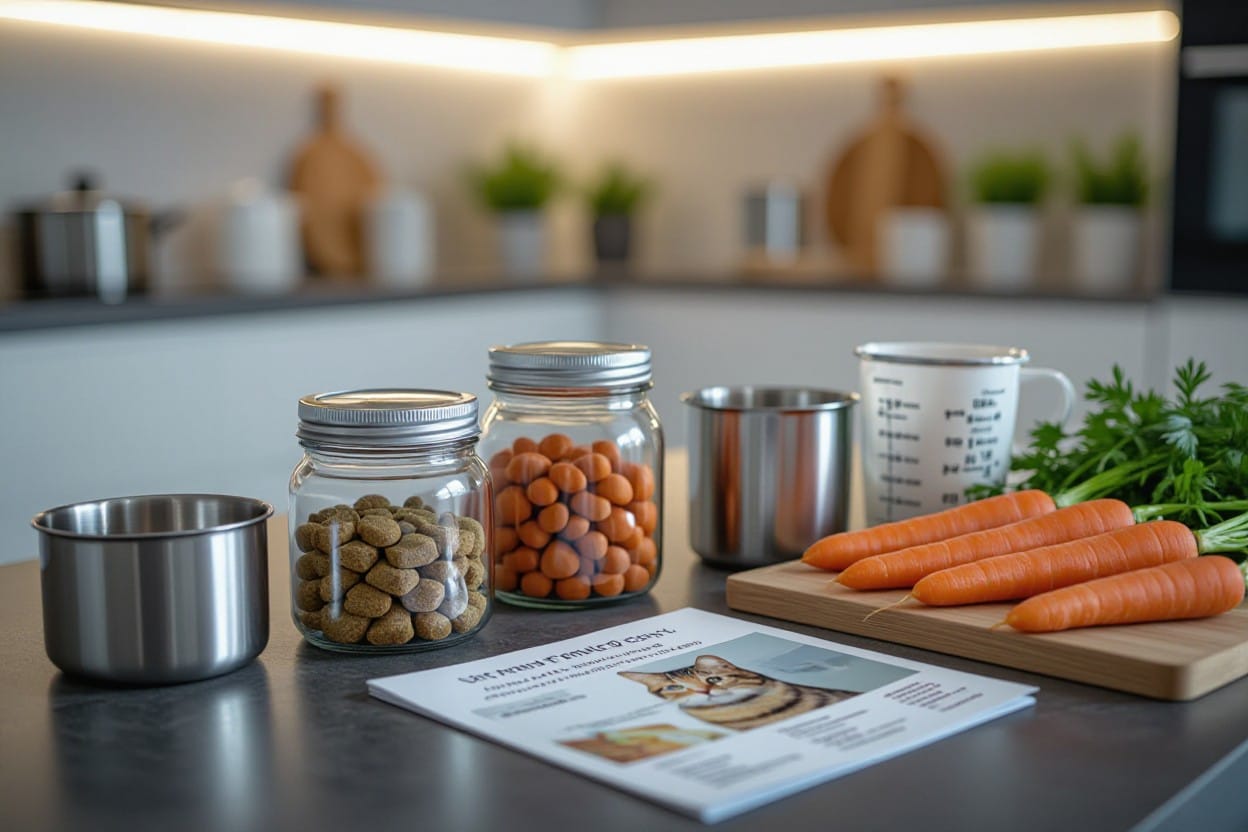
Adapting Treat Recipes for Different Life Stages
Kittens: Early Weight Management Strategies
Energy needs peak between about 3–6 months, so you should keep treats to no more than 10% of daily calories; for a rapidly growing 2 kg kitten that may be only 20–30 kcal worth of treats per day. Focus on very high-protein, taurine-containing options — tiny servings of pureed cooked chicken or low-sodium canned kitten tuna are good examples — and aim for 1–3 kcal per treat by freezing 1/2 tsp portions to control portions precisely.
Try a simple diet cat treats homemade option: blend cooked white meat (chicken or turkey) with a teaspoon of canned pumpkin for fiber and freeze in a silicone mold. Track weight and body condition score weekly with a target BCS of about 4–5/9, and avoid ingredients that are dangerous to cats such as onions, garlic, and grapes.
Adult Cats: Maintaining Healthy Weight
Typical indoor adult maintenance calories average ~20 kcal per pound (≈44 kcal/kg), so a 10 lb (4.5 kg) cat may need ~200 kcal/day; keep your healthy low calorie cat treats under 10% of that (≈20 kcal/day). Practical math: if a single homemade bite is ~4 kcal, limit to about five treats daily and make most rewards activity-based (puzzle feeders or food-dispensing toys).
For diet cat treats homemade, use lean turkey or white fish mixed with pureed pumpkin, formed into 12 mini bites (~6 kcal each) so you can trade quantity for quality without blowing the calorie budget. Freeze-dried single-ingredient treats let you deliver protein hits with very low calories; label and weigh each batch so you consistently hit your planned daily allowance.
When you target weight loss, aim for a safe reduction of about 1–2% body weight per week; adjust overall calories (not just treats) to create a 10–20% deficit and coordinate with your vet. Overfeeding treats undermines progress, so use low-calorie enrichment and the keyword-friendly homemade low calorie cat treats weight loss recipes to create satisfying, portion-controlled rewards.
Senior Cats: Adjusting for Aging Bodies
Activity often declines with age while the need to preserve lean mass increases, so you should shift toward high-quality protein in softer formats — mousse-style treats made from slow-cooked fish or chicken pureed with bone broth and a pinch of powdered gelatin work well for cats with dental issues. Keep treat calories low and dense in protein so each bite supports muscle: aim for small portions and consider soft, high-protein mini treats under 5 kcal each.
Include joint- and gut-friendly ingredients like a small amount of fish oil (omega-3) and soluble fiber (canned pumpkin) in your recipes, but limit phosphorus-heavy components if your senior has kidney concerns. Monitor muscle condition score as well as weight so you don’t trade fat loss for muscle loss.
Any significant health condition in a senior cat (kidney disease, hyperthyroidism, dental disease) means you should tailor treats with your vet; avoid high-phosphorus organ meats in those cases and prioritize preserving muscle while controlling calories.
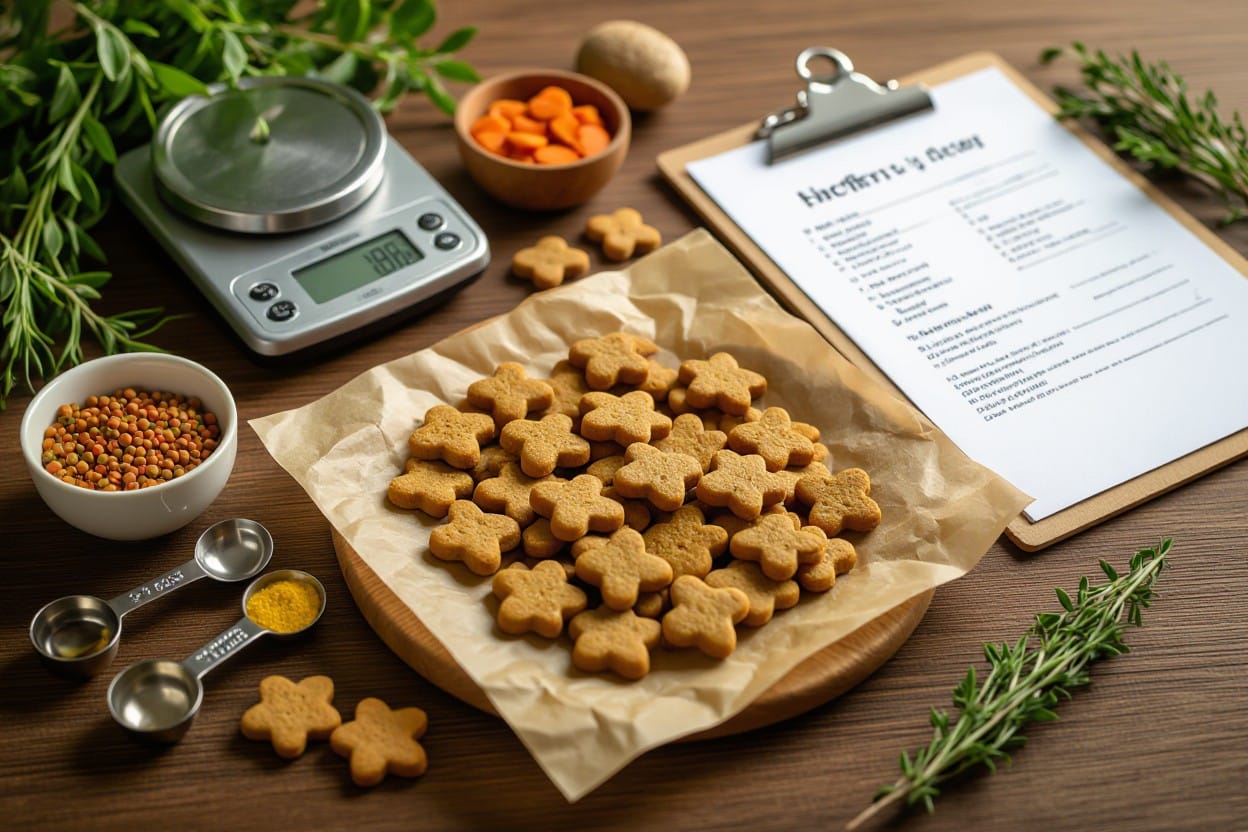
Building a Support System
Engaging Family Members in the Process
Assign specific, measurable tasks so everyone knows their role: one person measures meals and treats with a kitchen scale, another logs weekly weights, and a third handles activity sessions like two 10-minute play sessions daily. For a typical 4 kg cat that needs roughly 180–200 kcal/day, limit treats to no more than 10% of daily calories (about 18–20 kcal/day), which means choosing healthy low calorie cat treats that are often 3–5 kcal per piece or preparing controlled portions from your diet cat treats homemade recipes.
Replace high-calorie table scraps with nonfood rewards such as extra play, grooming, or a new toy to avoid accidental calorie creep. Keep an eye on dangerous foods: onions, garlic, chocolate, grapes/raisins and xylitol are toxic to cats, and family members need clear rules to prevent well-meaning but harmful handouts.
Online Communities and Support Groups
Join vet-moderated Facebook groups and specialized forums where members share portioned recipes, ingredient swaps, and tracking templates for homemade low calorie cat treats weight loss recipes. Use shared spreadsheets or pet-weight-tracking apps to post your cat’s weekly weight and caloric allowance; seeing consistent data encourages adherence and helps you spot stalls or regressions early.
Peer-led advice can identify practical hacks—puzzle feeders that slow feeding, toy-based treat dispensers, or switching from high-fat commercial treats to single-ingredient freeze-dried fish—while keeping the focus on weight management cat treats that fit your cat’s daily calorie budget.
Vet-reviewed threads and groups that require moderator approval reduce risky suggestions; watch for advice that pushes >2% bodyweight loss per week, since rapid weight loss raises the risk of hepatic lipidosis, and prioritize communities that emphasize gradual targets like 0.5–2% weekly.
Professional Support from Pet Nutritionists
Work with a board-certified veterinary nutritionist or certified pet nutritionist to get an individualized calorie target, a written meal plan, and precise treat formulations—for example, recipes that yield 3 kcal per bite with macronutrient profiles adjusted to your cat’s needs. Expect a monitoring plan with scheduled weigh-ins every 1–2 weeks and adjustments based on progress; professionals often convert your chosen diet cat treats homemade recipes into per-piece calorie counts so you never guess.
Nutritionists can also recommend therapeutic or prescription diets when appropriate, and advise safe rates of weight loss tailored to your cat’s body condition score and comorbidities. Ask for sample recipes and portioning guides that transform common ingredients into consistent healthy low calorie cat treats that support slow, steady fat loss.
To find a qualified specialist, request a referral from your veterinarian or search for a Diplomate of the American College of Veterinary Nutrition (ACVN) or a certified pet nutritionist; confirm they provide written calorie breakdowns for any homemade low calorie cat treats weight loss recipes and an emergency plan should weight drop too quickly.
Final Words
Upon reflecting, you should prioritize healthy low calorie cat treats that support your cat’s overall wellbeing while aligning with veterinary guidance. By choosing vet-approved weight management cat treats and applying consistent portion control and ingredient scrutiny, you give your cat better chances of gradual weight loss and long-term health.
You can also make diet cat treats homemade to control calories and macronutrients, using homemade low calorie cat treats weight loss recipes recommended by your veterinarian to fit your cat’s specific needs. With measured portions, regular monitoring, and routine vet check-ins, you will manage your cat’s weight while maintaining the positive interactions that treat time provides.
FAQ
Q: What are healthy low calorie cat treats and how do they differ from regular treats?
A: Healthy low calorie cat treats are small, nutrient-lean snacks designed to satisfy cats without adding excess calories. They typically contain lean protein (chicken, turkey, fish), minimal carbohydrate fillers, and no added sugars, salts, or toxic ingredients (onion, garlic, xylitol). Compared with regular treats, they have fewer calories per piece (often under 5–15 kcal each), simpler ingredient lists, and are used to support weight management cat treats strategies or maintenance of ideal body condition.
Q: Can vets approve homemade weight management cat treats and what guidelines should recipes follow?
A: Many veterinarians will approve homemade treats when recipes follow basic nutritional and safety guidelines: limit calories per treat, prioritize high-quality lean protein, avoid harmful ingredients, and ensure treats don’t displace balanced meals. Aim for treats under 10 kcal each during a weight-loss plan, include small amounts of wet or pureed vegetables for fiber if tolerated, and avoid high-fat or high-carb binders. Share recipe details and your cat’s weight-loss goals with your vet so they can confirm portion sizes and safety.
Q: What are simple diet cat treats homemade recipes I can make quickly?
A: Easy, low-calorie homemade options:
– Chicken Puree Bites: 3 oz cooked skinless chicken breast, 1 tbsp plain canned pumpkin, blend until smooth, pipe into small dollops on a baking sheet, bake 15–20 min at 325°F. Yields ~12 treats (~6–8 kcal each).
– Tuna-Ice Cubes: 2 oz canned tuna in water mixed with 2 tbsp water, pour into ice cube tray, freeze; serve thawed. Each cube ~5–8 kcal.
– Egg White Crunchies: 2 egg whites whisked, thinly spread on parchment, bake at 200°F until crisp, break into small pieces. Each piece ~3–5 kcal.
These diet cat treats homemade examples fit into homemade low calorie cat treats weight loss recipes guidance—adjust portion sizes to total daily calorie targets and confirm with your vet.
Q: How many treats can I give my cat during a weight-loss program without stalling progress?
A: Keep treats to roughly 5–10% of daily caloric intake during weight loss. For example, if your cat’s target is 180 kcal/day, limit treats to about 9–18 kcal/day (one to three small low-calorie pieces). Use treats primarily for training or enrichment, and deduct their calories from the daily meal allotment. Monitor weight weekly and consult your veterinarian to adjust the plan if weight loss plateaus or your cat shows signs of hunger or lethargy.
Q: What safety, storage, and transition tips should I follow when introducing low-calorie treats?
A: Introduce new treats gradually over 3–7 days to watch for digestive upset or allergies. Observe stool quality and activity; stop treats if vomiting, diarrhea, or skin reactions occur and consult your vet. Store homemade treats in an airtight container: refrigerate up to 3–5 days or freeze portions for 1–2 months. Label with date and thaw in refrigerator before serving. Use treats as part of a broader weight management cat treats plan that includes portion-controlled meals and increased play or activity.
